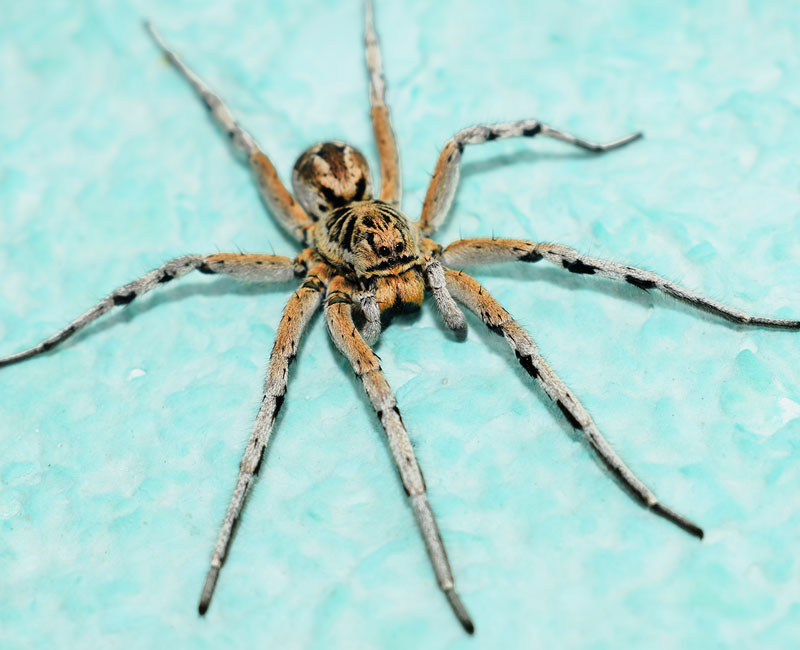Wolf spiders may look scary, but their venom isn’t dangerous to humans. Due to their size, a wolf spider bite may cause some pain and swelling. But these symptoms should subside on their own and you shouldn’t require medical attention. You can take steps to prevent wolf spider bites.
Advertisement
Cleveland Clinic is a non-profit academic medical center. Advertising on our site helps support our mission. We do not endorse non-Cleveland Clinic products or services. Policy

Yes, all spiders can bite. But the bite of a wolf spider is typically harmless. While it may puncture your skin and cause redness, pain and swelling, it doesn’t normally require medical attention.
Advertisement
Cleveland Clinic is a non-profit academic medical center. Advertising on our site helps support our mission. We do not endorse non-Cleveland Clinic products or services. Policy
Wolf spiders are one of the most common types of spiders. They live on all continents but Antarctica, and this family of spiders includes more than 2,400 species worldwide. They can be found in many different environments. You may encounter them outdoors — among fallen leaves, grassy areas or burrows. But you may also find them indoors, especially in basements, sheds and garages.
Wolf spiders get their name from the way they hunt their prey like a wolf. They don’t catch their prey by spinning webs. They use their excellent eyesight, and some build underground burrows so they can jump out and ambush prey that get too close to the opening. Like most spiders, wolf spiders have eight eyes — two of which are rather large — that shine in the light.
Wolf spiders can be dark brown or gray and may have stripes or markings down their backs. They use these markings to camouflage themselves. They can be hairy and large — up to 2 inches (5 centimeters) long in the U.S. — and are sometimes mistaken for brown recluses. But brown recluses have a violin-shaped marking on their head and only have six eyes.
Wolf spiders aren’t aggressive toward people. They usually only bite when they feel threatened, like when you trap them or unintentionally come into contact with them. If they do bite you, you may experience some uncomfortable symptoms. But you don’t typically need to worry because the venom of a wolf spider isn’t deadly.
Advertisement
Other types of spiders pose more danger. Brown recluses, along with black widows, are much more dangerous than wolf spiders. If you have a more severe reaction, you may have been bitten by one of these spiders. Rarely, people are allergic to all spider bites.
A wolf spider bite may look like a bug bite. You may notice a red bump and swelling in the bite area. In addition, a wolf spider may puncture your skin and leave fang-like marks. Other wolf spider bite symptoms may include pain and itching.
If you experience any symptoms of an allergic reaction from a spider bite, you should seek medical attention. Symptoms of an allergic reaction may include:
Wolf spiders aren’t usually aggressive toward humans. Bites only occur when a wolf spider feels threatened and needs to defend itself.
Anyone can accidentally make contact with a wolf spider and get bitten. But certain people may be at a higher risk due to their jobs or actions that put them in closer contact with places where these spiders live. People at risk include:
There’s no test that can tell what kind of spider bit you. Seeing the spider is the only way to determine if it was a wolf spider. But your provider may make a diagnosis of a spider bite based on a physical exam and your symptoms.
Wolf spider bite treatment includes measures to avoid infection and manage any pain, swelling or itching. You can take the following at-home steps to treat a wolf spider bite:
Your symptoms should clear up on their own within a few days. See your healthcare provider if your symptoms persist or get worse.
If a wolf spider bites you, you may experience mild symptoms like pain and swelling. But these symptoms should slowly go away with at-home care.
Most wolf spider bites are harmless and don’t require any medical attention. But if your symptoms get worse or don’t go away after a few days of self-care, reach out to your healthcare provider for further treatment.
Advertisement
To protect yourself and your family from wolf spider bites, give them fewer reasons to hang around:
If you develop any of the following symptoms after a wolf spider bite, you should see your healthcare provider:
If you’re experiencing symptoms of anaphylaxis, seek emergency medical attention.
In addition, you might not be certain what kind of spider bit you, so you may want to err on the side of caution if you think you might need care.
If you’re worried about a wolf spider bite, you may want to ask your provider:
Advertisement
Wolf spiders are big, hairy and scary-looking, but they only bite when they feel the need to defend themselves. When they do bite, they’re typically harmless because their venom doesn’t pose a danger to humans. While you may experience some uncomfortable symptoms, they should go away within a few days. If the symptoms don’t pass or you’re experiencing a more severe reaction, reach out to your healthcare provider.
Advertisement
Cleveland Clinic’s primary care providers offer lifelong medical care. From sinus infections and high blood pressure to preventive screening, we’re here for you.

Last reviewed on 06/10/2024.
Learn more about the Health Library and our editorial process.